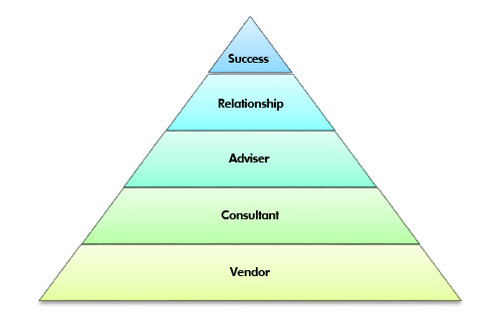5 Ways to Nurture Professional Relationships
Professional relationships, just like personal relationships, need honesty, trust and respect in order to grow and succeed. In the association world, there are a number of relationships that require care and attention. Naylor Association Solution’s Group Publisher John Bacon, MBA, and Jamie Williams, a veteran sales representative with nearly 20 years of experience, recently talked to Association Adviser about the ways that they nurture professional relationships with associations and advertisers, respectively. What they found is that there are five basic truths that form the foundation of a strong professional relationship.
1. Be Reliable

John Bacon, MBA: Reliability and follow through are two of the most important pieces to nurturing relationships. The two go hand in hand; consistent follow through builds up your “reliability bank.” It’s a fact these days that everyone is busy; return emails, phone calls and follow up after meetings in a timely manner. This shows that you’re reliable and considerate of others’ time in a fast-paced world. At Naylor, I work with many different associations – and all of them are as important as the next when it comes to the work they’re doing for their members. Whether we partner with an association on one monthly newsletter or their entire communications platform, I cultivate a relationship with each and every association. The same applies to working with my sales team internally. My team knows that I am busy, and I know that they are busy. Being responsive and timely helps our team succeed. Consistency is also a key driver when it comes to reliability. Never start something you do not have the ability to continue.

Jamie Williams: Reliability with advertisers is of the utmost importance. It’s how you build your name, your credibility and, ultimately, your advertiser and sponsor base. It’s also how you gain trust. Advertisers are pitched constantly, but the key to building a relationship with that company is regular, consistent follow-up. There are studies that indicate that you must follow up with a potential advertiser about a buying decision at least five times before they say yes. Most individuals give up after 2-3 times. DON’T give up. Use those five calls to show your character. When you tell a client you are going to send them something, send it. Give yourself (and them) a timeline. For example: “John, thank you so much for our conversation today about advertising. I will send over proposal ideas in 15 minutes. If I get this to you by then, can we reconnect later in the day?”
2. Get to Know Each Other
JB: Association executives, staff and members are people, too. It is OK to be personable. When on a call or meeting in person, I make it a point to start every conversation focusing on anything but work. My associations know I’m there to discuss their goals and objectives – that’s no secret. I use every opportunity to LISTEN and learn about who they are. This allows me to open up and learn more about them, and it allows them to get to know me better as well. Best-selling author Bob Burg says to always remember the Golden Rule of Sales: “All things being equal, people will do business with, and refer business to, those people they know, like and trust.”
JW: It is so much easier to sell someone on a product or service when they trust you, so gaining that trust is essential. When I work with an advertiser, I ask about their family and what’s going on in their life, and I let them know that I share the same milestones and struggles they do. Earning trust is a process, and it has to start somewhere. I also want to know their company’s goals. I’ve had the opportunity to pitch some multimillion-dollar organizations. One thing that stands out in nearly every meeting: I know almost as much about their company as they do. I do my research. When I make a sales pitch, I provide them with the research I’ve done and show why the advertising I’m pitching fits with their goals. I want them to think of me as a partner, not a salesperson.
3. Meet Them Where They Are
JB: How many times have you asked yourself, “Why don’t they take my calls? Why don’t they respond to my emails?” My preferred method of communication is not necessarily the method my associations prefer. I now ask my associations what is the best way for me to communicate with them. Doing this shows them that their needs are a priority, I respect their time, and I want to make it as convenient as possible for them to get back to me in a timely manner.
JW: This rule can be harder than most because it means you have to be willing to adapt to different forms of communication. When I first started my career in sales 18 years ago, the phone and in person were the only options. With so many people on email all day long now, you need to make sure your emails are easy to read and concise. Do not send long emails that no one has time to read! Try communication through LinkedIn, Twitter and other social media platforms. Do not get trapped into thinking that because an advertiser doesn’t return your email that your voicemail won’t be returned, or that they’ll find a LinkedIn Private Message intrusive. More professionals today are open to communicating via text as well. Try different ways of communicating and be willing to adapt to what the advertiser wants.
4. Don’t Sell, Consult!
JB: Empowering and educating your members will separate you from the crowd. A consultative approach means being able to help your members, sponsors and advertisers get the results they need based on their goals and objectives – not based on what you need. Have a conversation, listen, and recommend solutions that make sense and address the challenges they face. When I do that, the best part is I don’t feel like I’m selling anything. Instead, I’m able to work with associations to come up with solutions that benefit everyone. I often refer to leadership trainer and change expert Susan Young’s “Evolution of Professional Relationships,” which help illustrate this point of how consulting and nurturing a professional relationship leads to success.
JW: When I’m asked what I do for a living, I often hear, “Oh, you are an annoying salesperson.” Even though that is technically my title, I don’t think of myself as a salesperson; I’m a consultant. When I call someone, I offer ideas and suggestions, but the advertisers sell themselves. I simply find out what they are trying to accomplish, who they want to target and then deliver ideas that can help them achieve their goals. Remember most potential advertisers will tell you no at first, but that is how the buying process starts. Do not sell them, but try to help them. Figure out their goals and objectives, and then find solutions that deliver value – even if it’s not something you offer. They will eventually come back to you for advice, strengthening that relationship down the road.
5. “I’m Sorry” Is Not Enough
JB: For leaders, pointing fingers is not an option. When I’m wrong or my team does something wrong, it is my responsibility to make it right. We are human; we all make mistakes. It’s what we do after the mistake and the effort we put into fixing it that helps to strengthen and nurture relationships. It’s still important to apologize, but it is more meaningful when you make every effort to make sure the mistake doesn’t happen again. Clear, open communication is the way to make this happen.
JW: We all make mistakes: Ads don’t run (or run incorrectly) and sponsorships go array. It happens. So when it does, own it. Timely resolution of the problem is important. Do not let these issues drag on for weeks. It will stress you out and plant the seeds of disbelief in your advertiser. Apologize, but let them know that you want to make it right, then give yourself a deadline to make it happen. Explain to the advertiser what will happen next. For example, “John, I’m sorry the ad didn’t run. It will take me today to figure out what happened, and by tomorrow morning I will get back to you with a solution.” If tomorrow morning comes and you still don’t have a solution, continue communicating. Don’t let one bad experience sour the relationship.



